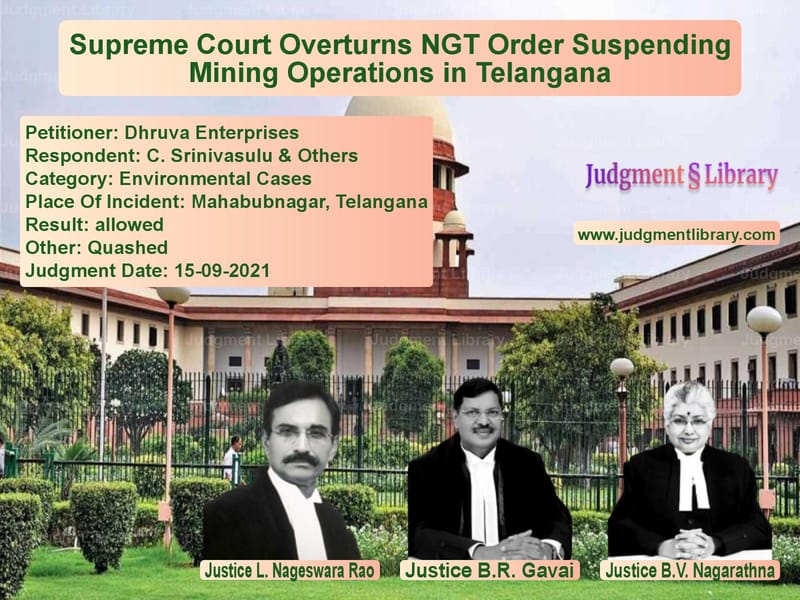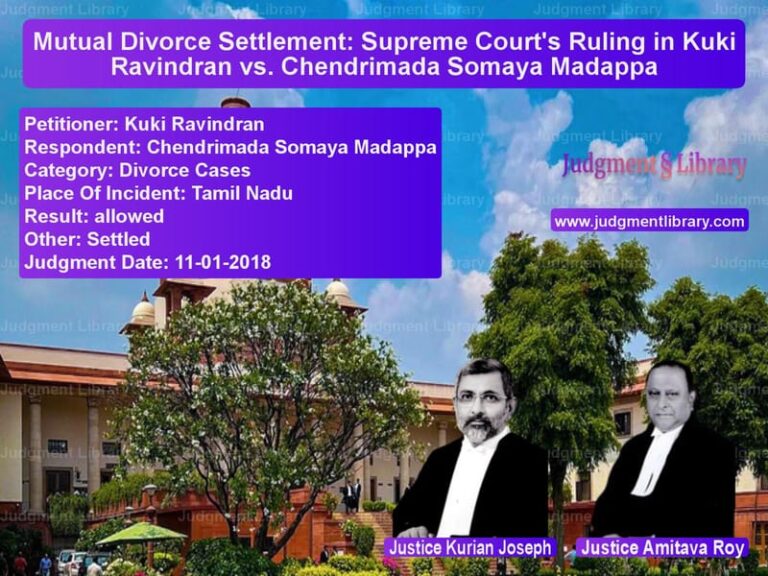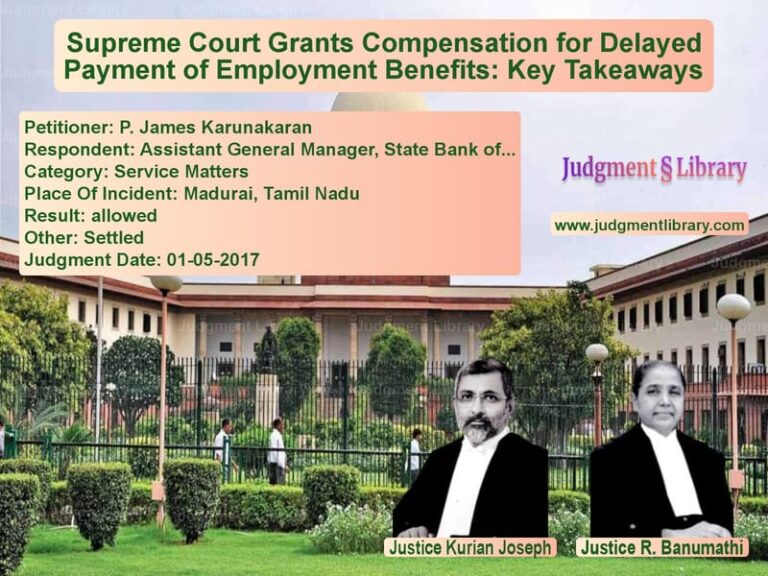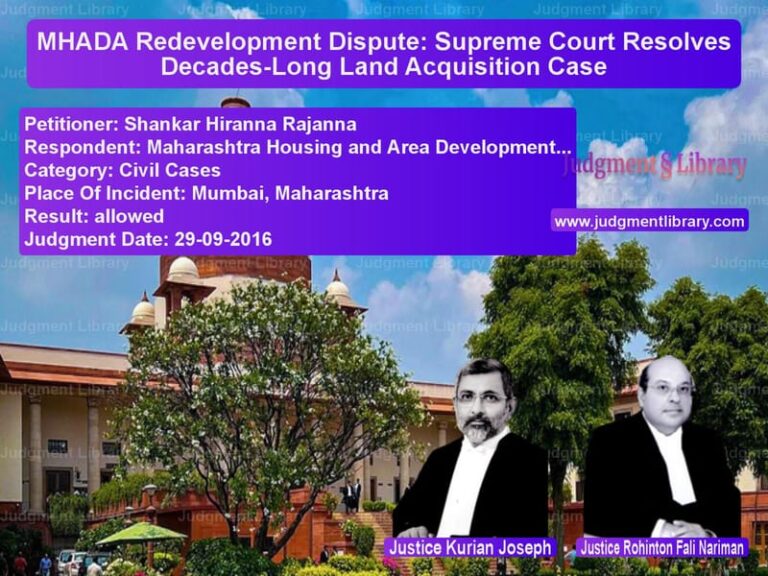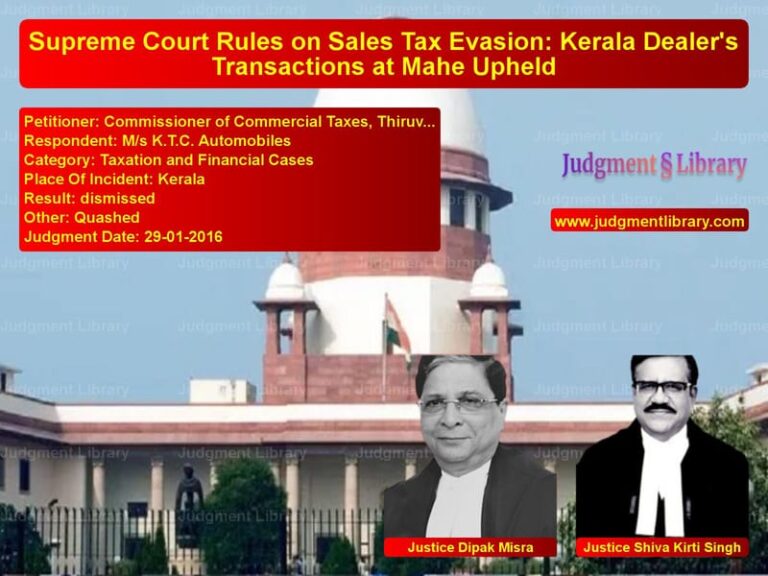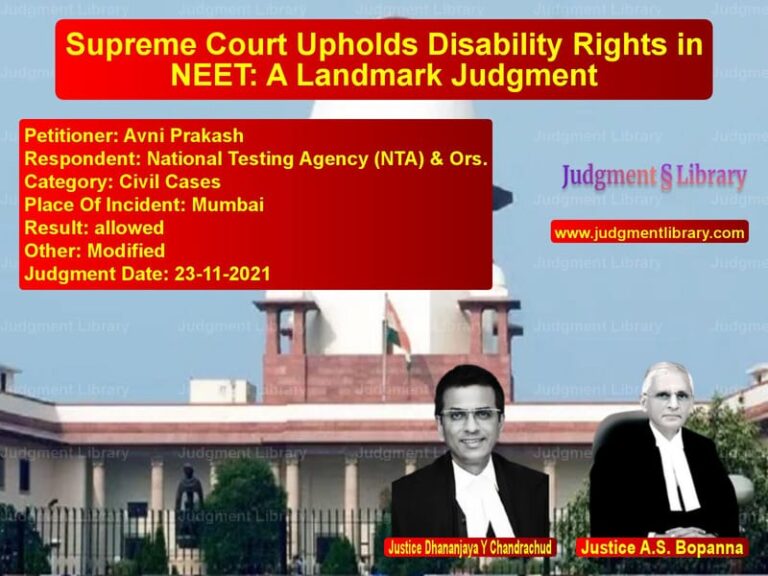Supreme Court Overturns NGT Order Suspending Mining Operations in Telangana
The Supreme Court of India, in the case of Dhruva Enterprises vs. C. Srinivasulu & Others, overturned the National Green Tribunal’s (NGT) decision to suspend a mining project in Telangana. The ruling emphasized the importance of following due legal processes and ensuring that environmental clearance (EC) decisions are based on evidence rather than assumptions.
Background of the Case
The appellant, Dhruva Enterprises, had applied for a mining lease for Quartz and Feldspar over an area of 29 hectares in Kalwakole Village, Peddakothapally Mandal, Mahabubnagar District, Telangana. After scrutiny by various authorities, the State granted a mining lease for 24 hectares, and the company obtained an Environmental Clearance (EC) from the Telangana State Environmental Impact Assessment Authority (SEIAA).
However, respondents, including local villagers, challenged the EC before the National Green Tribunal (NGT), Principal Bench, Delhi, arguing that:
- The mining lease area was reduced to 24 hectares to avoid the requirement of a public hearing, which is mandatory for areas above 25 hectares.
- The proposed mine was too close to Singotham Lake, a crucial water body, violating environmental norms.
The NGT allowed the appeal, directing the Ministry of Environment, Forest, and Climate Change (MoEF) to reassess the EC and suspend mining operations until a fresh Environmental Impact Assessment (EIA) was conducted. Aggrieved by this order, Dhruva Enterprises appealed to the Supreme Court.
Supreme Court’s Key Observations
1. Reduction of Lease Area Was Not Intentional
The Supreme Court rejected the NGT’s finding that the lease area was deliberately reduced to 24 hectares to bypass the public hearing requirement. The Court noted that the authorities, not the appellant, had decided to grant the lease over a smaller area:
“The appellant had applied for a lease over 29 hectares. The reduction to 24 hectares was a decision made by the authorities, not an attempt to circumvent legal requirements.”
2. Compliance with Environmental Regulations
The Court examined whether the required distance from the water body had been maintained. The NGT had concluded that the mining area was too close to Singotham Lake. However, the Supreme Court found that multiple surveys confirmed the distance requirement was met:
“The site inspections, GPS surveys, and reports from various agencies all indicate that the distance of 0.25 km between the mining area and the lake was maintained.”
3. Proper Grant of Environmental Clearance
The Supreme Court reviewed the procedures followed in granting the EC. It found that the Telangana State Environmental Impact Assessment Authority (SEIAA) had properly evaluated the proposal before granting clearance:
“The EC was granted after a rigorous review process, including site inspections, expert committee evaluations, and adherence to the EIA Notification of 2006.”
4. NGT’s Overreach in Suspending Mining Operations
The Court criticized the NGT for ordering the suspension of mining activities without sufficient justification. It stated:
“The Tribunal’s direction to halt mining operations lacked a legal basis. It was based on assumptions rather than substantive evidence.”
Final Judgment
The Supreme Court ruled in favor of Dhruva Enterprises and set aside the NGT’s order:
- The mining lease granted to Dhruva Enterprises was restored.
- The Environmental Clearance issued by SEIAA was upheld.
- Mining operations were permitted to resume immediately.
Implications of the Judgment
This ruling has significant implications for environmental governance and mining regulations in India:
1. Preventing Arbitrary Suspensions
The decision ensures that environmental clearances cannot be arbitrarily overturned without concrete evidence of violations.
2. Clarification on Public Hearing Requirements
The ruling clarifies that if authorities reduce the lease area, it does not automatically imply an attempt to evade legal obligations.
3. Strengthening Due Process
The judgment reinforces that all stakeholders, including businesses and regulatory bodies, must adhere to legal procedures in environmental decision-making.
Conclusion
The Supreme Court’s decision in Dhruva Enterprises vs. C. Srinivasulu & Others underscores the need for a balanced approach to environmental regulation. By reinstating the mining lease, the Court emphasized the importance of evidence-based decision-making while ensuring that environmental safeguards are not misused to stall legitimate industrial projects.
Petitioner Name: Dhruva Enterprises.Respondent Name: C. Srinivasulu & Others.Judgment By: Justice L. Nageswara Rao, Justice B.R. Gavai, Justice B.V. Nagarathna.Place Of Incident: Mahabubnagar, Telangana.Judgment Date: 15-09-2021.
Don’t miss out on the full details! Download the complete judgment in PDF format below and gain valuable insights instantly!
Download Judgment: dhruva-enterprises-vs-c.-srinivasulu-&-oth-supreme-court-of-india-judgment-dated-15-09-2021.pdf
Directly Download Judgment: Directly download this Judgment
See all petitions in Environmental Cases
See all petitions in Public Interest Litigation
See all petitions in Dispute Resolution Mechanisms
See all petitions in Judgment by L. Nageswara Rao
See all petitions in Judgment by B R Gavai
See all petitions in Judgment by B.V. Nagarathna
See all petitions in allowed
See all petitions in Quashed
See all petitions in supreme court of India judgments September 2021
See all petitions in 2021 judgments
See all posts in Environmental Cases Category
See all allowed petitions in Environmental Cases Category
See all Dismissed petitions in Environmental Cases Category
See all partially allowed petitions in Environmental Cases Category

